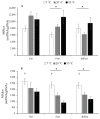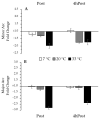The Acute Effects of Exercise and Temperature on Regional mtDNA
- PMID: 34204828
- PMCID: PMC8296217
- DOI: 10.3390/ijerph18126382
The Acute Effects of Exercise and Temperature on Regional mtDNA
Abstract
A reduced mitochondrial DNA (mtDNA) copy number, the ratio of mitochondrial DNA to genomic DNA (mtDNA:gDNA), has been linked with dysfunctional mitochondria. Exercise can acutely induce mtDNA damage manifested as a reduced copy number. However, the influence of a paired (exercise and temperature) intervention on regional mtDNA (MINor Arc and MAJor Arc) are unknown. Thus, the purpose of this study was to determine the acute effects of exercise in cold (7 °C), room temperature (20 °C), and hot (33 °C) ambient temperatures, on regional mitochondrial copy number (MINcn and MAJcn). Thirty-four participants (24.4 ± 5.1 yrs, 87.1 ± 22.1 kg, 22.3 ± 8.5 %BF, and 3.20 ± 0.59 L·min-1 VO2peak) cycled for 1 h (261.1 ± 22.1 W) in either 7 °C, 20 °C, or 33 °C ambient conditions. Muscle biopsy samples were collected from the vastus lateralis to determine mtDNA regional copy numbers via RT-qPCR. mtDNA is sensitive to the stressors of exercise post-exercise (MIN fold change, -1.50 ± 0.11; MAJ fold change, -1.70 ± 0.12) and 4-h post-exercise (MIN fold change, -0.82 ± 0.13; MAJ fold change, -1.54 ± 0.11). The MAJ Arc seems to be more sensitive to heat, showing a temperature-trend (p = 0.056) for a reduced regional copy number ratio after exercise in the heat (fold change -2.81 ± 0.11; p = 0.019). These results expand upon our current knowledge of the influence of temperature and exercise on the acute remodeling of regional mtDNA.
Keywords: ambient temperature; copy number; exercise; mitochondria; mtDNA; thermoregulation.
Conflict of interest statement
The authors declare no competing interests, financial or otherwise.
Figures




References
-
- Hsieh R.H., Hou J.H., Hsu H.S., Wei Y.H. Age-dependent respiratory function decline and DNA deletions in human muscle mitochondria. Biochem. Mol. Biol. Int. 1994;32:1009–1022. - PubMed
Publication types
MeSH terms
Substances
Grants and funding
LinkOut - more resources
Full Text Sources
Medical
Miscellaneous

